Taxation Law Assignment: CGT, Income from Personal Exertion, Loans
VerifiedAdded on 2023/01/18
|7
|2678
|39
Homework Assignment
AI Summary
This document provides a comprehensive solution to a taxation law assignment, addressing three key questions. Question 1 analyzes the capital gains tax (CGT) implications for a fashion designer, Helen, who sold various assets, including a pre-CGT painting, a historical sculpture, antique jewelry, and a picture. The analysis determines CGT liabilities based on purchase and sale dates, cost bases, and relevant legislation. Question 2 examines whether proceeds received by an economic researcher, Barbara, from writing a book, manuscript sales, and interview transcripts constitute income from personal exertion, considering factors like the source of value and profit motive. Question 3 explores the tax consequences for David and his father Patrick, involving a loan provided by Patrick to David and the subsequent repayment with interest. The analysis determines whether the interest received by Patrick is assessable income or non-assessable income, considering the nature of the loan and the absence of a money-lending business or profit motive. The solution incorporates relevant Australian tax law, including ITAA 1997 sections and case law, to provide a detailed and legally sound analysis of each scenario.
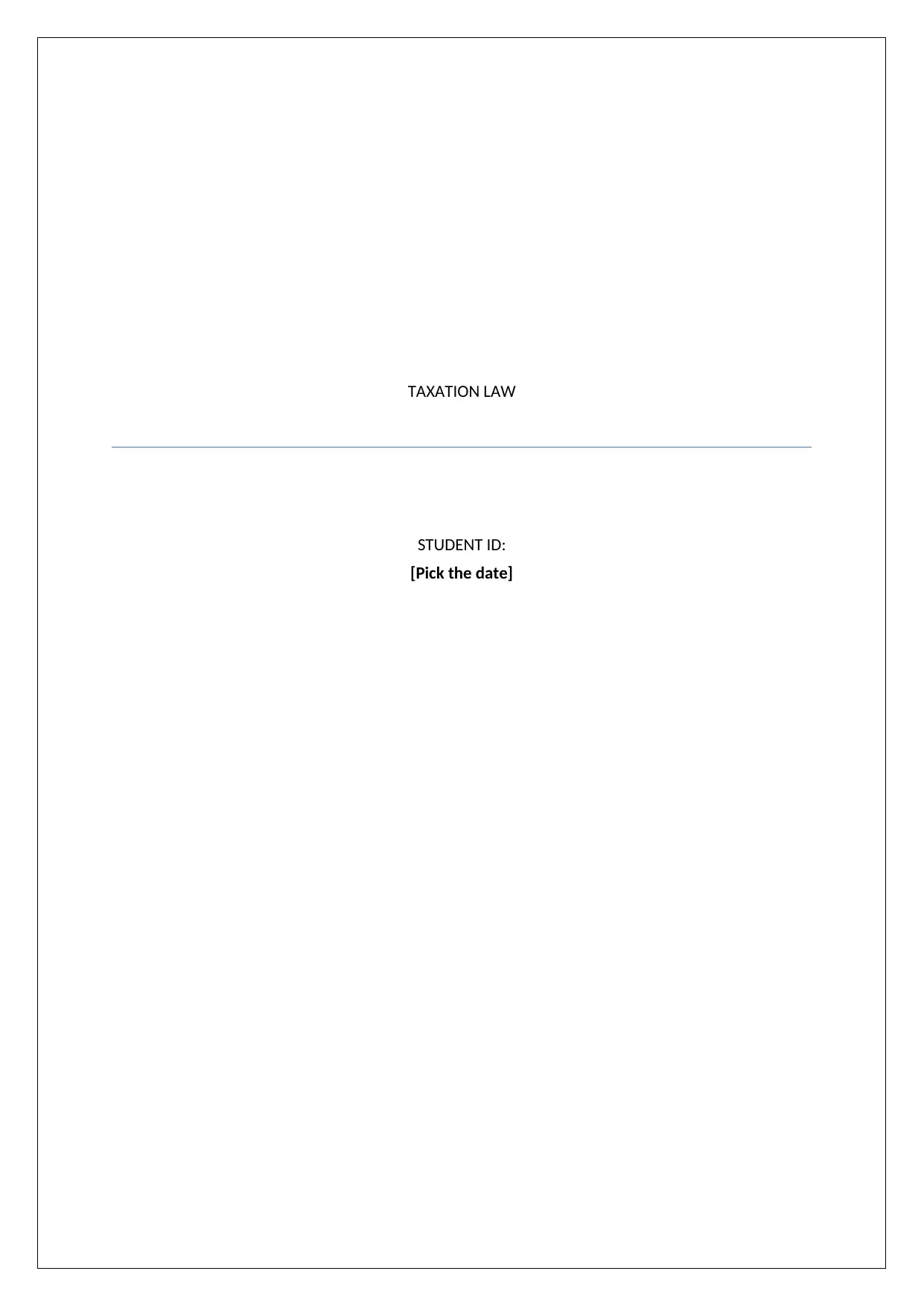
TAXATION LAW
STUDENT ID:
[Pick the date]
STUDENT ID:
[Pick the date]
Paraphrase This Document
Need a fresh take? Get an instant paraphrase of this document with our AI Paraphraser

Question 1
Taxpayer Helen wanted to raise funds for her business as fashion designer and
therefore, she has sold some of her capital assets. The objective here is to estimate
the net capital gains or capital losses so as to provide a legal advice to Helen
regarding her Capital Gains Tax (CGT) consequences under the highlights of
relevant statutory law.
1) Helen’s father bought an antique impressionism painting
The required details about the capital asset are given below.
Month of purchase February, 1985
Purchasing cost $4000
Selling date December 1, 2018
Sale proceeds received $12,000
Holding period more than one year Yes
(Long-term asset)
The implication of the CGT on the produced capital gains/losses has been
highlighted in s. 149 (10) ITAA 1997 which also refers that CGT would not be levied
on the taxpayer when he/she disposed the pre-CGT asset. Any asset that has been
purchased on the part of the concerned taxpayer earlier than September 20, 1985 is
named as pre-CGT asset (Austlii, 2019). This is because CGT came into existence
only on September 20 1985 which means the assets that are purchased before this
date are free from any CGT implications. In regards to this case, Helen sold the
painting which her father bought in February 1985. Clearly, the painting purchase
has taken place before the period of CGT establishment. Hence, the asset is defined
as pre-CGT asset and CGT would not be levied on any capital gains related to asset.
2) Helen disposed her historical sculpture
The required details about the capital asset are given below.
Month of Purchase December, 1993
Purchasing cost $5,5000
Selling date January 1, 2018
Sale proceeds received $6,000
Holding period more than one year Yes
(Long-term asset)
Historical sculpture is considered as part of the collectibles and thus, capital asset as
evident from the provisions given in ss. 108 (10) ITAA 1997. From the data
represented in the above table, it is evident that the purchasing of sculpture has
been done after the establishment of CGT regime. Hence, CGT will be levied on the
capital gains/losses received from the disposal of asset. The transaction of sale for
capital asset is classified as A1 CGT event under ss. 104(5) ITA 1997.It means the
relevant formula for computation of capital gains/losses includes sale proceeds and
cost base of asset as given in ss. 104(10) ITAA 1997 (Barkoczy, 2017).
Capital gains
= Sale proceeds received - Sale proceeds
= $6,000 - $5,500
= $ 500
2
Taxpayer Helen wanted to raise funds for her business as fashion designer and
therefore, she has sold some of her capital assets. The objective here is to estimate
the net capital gains or capital losses so as to provide a legal advice to Helen
regarding her Capital Gains Tax (CGT) consequences under the highlights of
relevant statutory law.
1) Helen’s father bought an antique impressionism painting
The required details about the capital asset are given below.
Month of purchase February, 1985
Purchasing cost $4000
Selling date December 1, 2018
Sale proceeds received $12,000
Holding period more than one year Yes
(Long-term asset)
The implication of the CGT on the produced capital gains/losses has been
highlighted in s. 149 (10) ITAA 1997 which also refers that CGT would not be levied
on the taxpayer when he/she disposed the pre-CGT asset. Any asset that has been
purchased on the part of the concerned taxpayer earlier than September 20, 1985 is
named as pre-CGT asset (Austlii, 2019). This is because CGT came into existence
only on September 20 1985 which means the assets that are purchased before this
date are free from any CGT implications. In regards to this case, Helen sold the
painting which her father bought in February 1985. Clearly, the painting purchase
has taken place before the period of CGT establishment. Hence, the asset is defined
as pre-CGT asset and CGT would not be levied on any capital gains related to asset.
2) Helen disposed her historical sculpture
The required details about the capital asset are given below.
Month of Purchase December, 1993
Purchasing cost $5,5000
Selling date January 1, 2018
Sale proceeds received $6,000
Holding period more than one year Yes
(Long-term asset)
Historical sculpture is considered as part of the collectibles and thus, capital asset as
evident from the provisions given in ss. 108 (10) ITAA 1997. From the data
represented in the above table, it is evident that the purchasing of sculpture has
been done after the establishment of CGT regime. Hence, CGT will be levied on the
capital gains/losses received from the disposal of asset. The transaction of sale for
capital asset is classified as A1 CGT event under ss. 104(5) ITA 1997.It means the
relevant formula for computation of capital gains/losses includes sale proceeds and
cost base of asset as given in ss. 104(10) ITAA 1997 (Barkoczy, 2017).
Capital gains
= Sale proceeds received - Sale proceeds
= $6,000 - $5,500
= $ 500
2
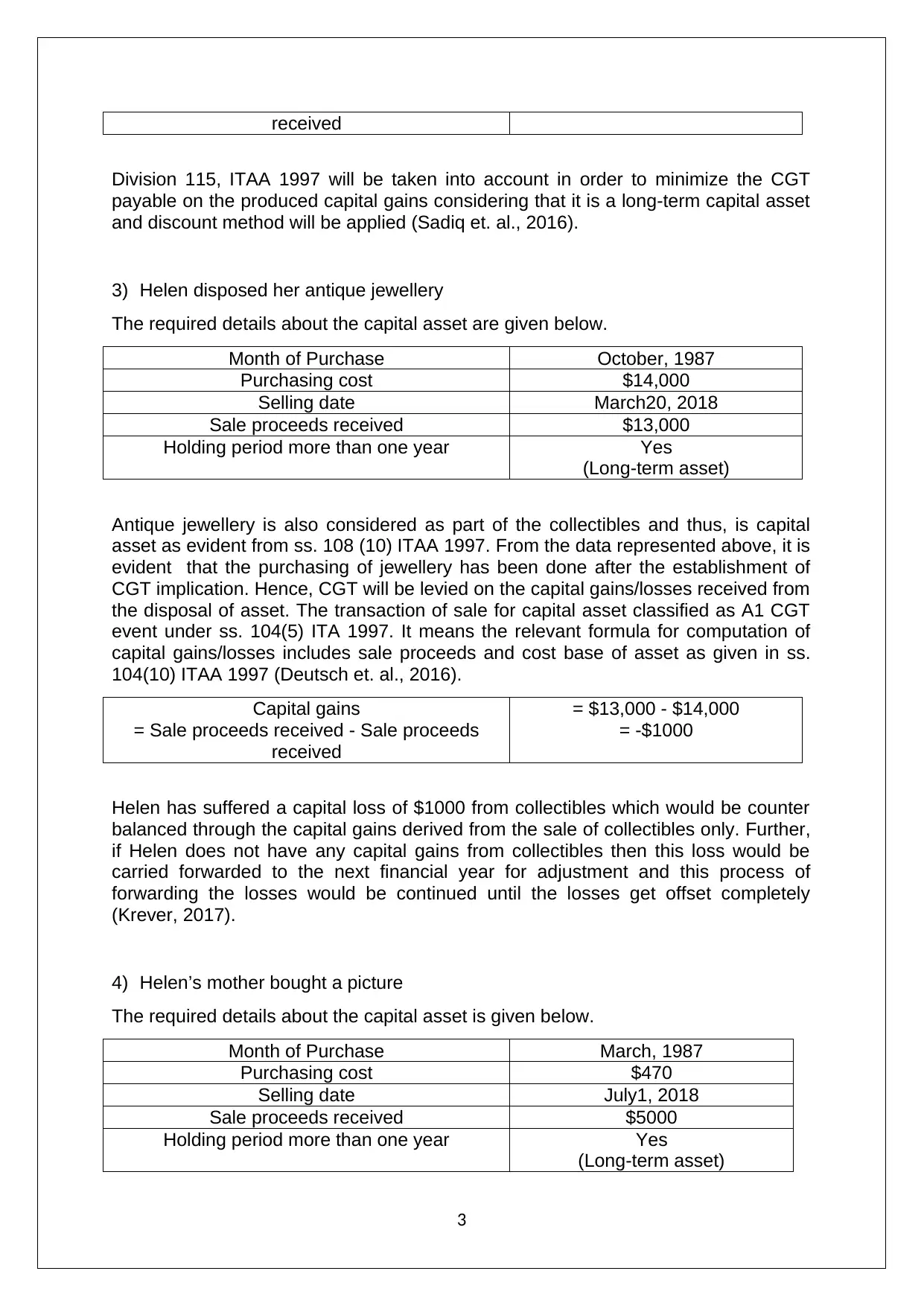
received
Division 115, ITAA 1997 will be taken into account in order to minimize the CGT
payable on the produced capital gains considering that it is a long-term capital asset
and discount method will be applied (Sadiq et. al., 2016).
3) Helen disposed her antique jewellery
The required details about the capital asset are given below.
Month of Purchase October, 1987
Purchasing cost $14,000
Selling date March20, 2018
Sale proceeds received $13,000
Holding period more than one year Yes
(Long-term asset)
Antique jewellery is also considered as part of the collectibles and thus, is capital
asset as evident from ss. 108 (10) ITAA 1997. From the data represented above, it is
evident that the purchasing of jewellery has been done after the establishment of
CGT implication. Hence, CGT will be levied on the capital gains/losses received from
the disposal of asset. The transaction of sale for capital asset classified as A1 CGT
event under ss. 104(5) ITA 1997. It means the relevant formula for computation of
capital gains/losses includes sale proceeds and cost base of asset as given in ss.
104(10) ITAA 1997 (Deutsch et. al., 2016).
Capital gains
= Sale proceeds received - Sale proceeds
received
= $13,000 - $14,000
= -$1000
Helen has suffered a capital loss of $1000 from collectibles which would be counter
balanced through the capital gains derived from the sale of collectibles only. Further,
if Helen does not have any capital gains from collectibles then this loss would be
carried forwarded to the next financial year for adjustment and this process of
forwarding the losses would be continued until the losses get offset completely
(Krever, 2017).
4) Helen’s mother bought a picture
The required details about the capital asset is given below.
Month of Purchase March, 1987
Purchasing cost $470
Selling date July1, 2018
Sale proceeds received $5000
Holding period more than one year Yes
(Long-term asset)
3
Division 115, ITAA 1997 will be taken into account in order to minimize the CGT
payable on the produced capital gains considering that it is a long-term capital asset
and discount method will be applied (Sadiq et. al., 2016).
3) Helen disposed her antique jewellery
The required details about the capital asset are given below.
Month of Purchase October, 1987
Purchasing cost $14,000
Selling date March20, 2018
Sale proceeds received $13,000
Holding period more than one year Yes
(Long-term asset)
Antique jewellery is also considered as part of the collectibles and thus, is capital
asset as evident from ss. 108 (10) ITAA 1997. From the data represented above, it is
evident that the purchasing of jewellery has been done after the establishment of
CGT implication. Hence, CGT will be levied on the capital gains/losses received from
the disposal of asset. The transaction of sale for capital asset classified as A1 CGT
event under ss. 104(5) ITA 1997. It means the relevant formula for computation of
capital gains/losses includes sale proceeds and cost base of asset as given in ss.
104(10) ITAA 1997 (Deutsch et. al., 2016).
Capital gains
= Sale proceeds received - Sale proceeds
received
= $13,000 - $14,000
= -$1000
Helen has suffered a capital loss of $1000 from collectibles which would be counter
balanced through the capital gains derived from the sale of collectibles only. Further,
if Helen does not have any capital gains from collectibles then this loss would be
carried forwarded to the next financial year for adjustment and this process of
forwarding the losses would be continued until the losses get offset completely
(Krever, 2017).
4) Helen’s mother bought a picture
The required details about the capital asset is given below.
Month of Purchase March, 1987
Purchasing cost $470
Selling date July1, 2018
Sale proceeds received $5000
Holding period more than one year Yes
(Long-term asset)
3
⊘ This is a preview!⊘
Do you want full access?
Subscribe today to unlock all pages.

Trusted by 1+ million students worldwide
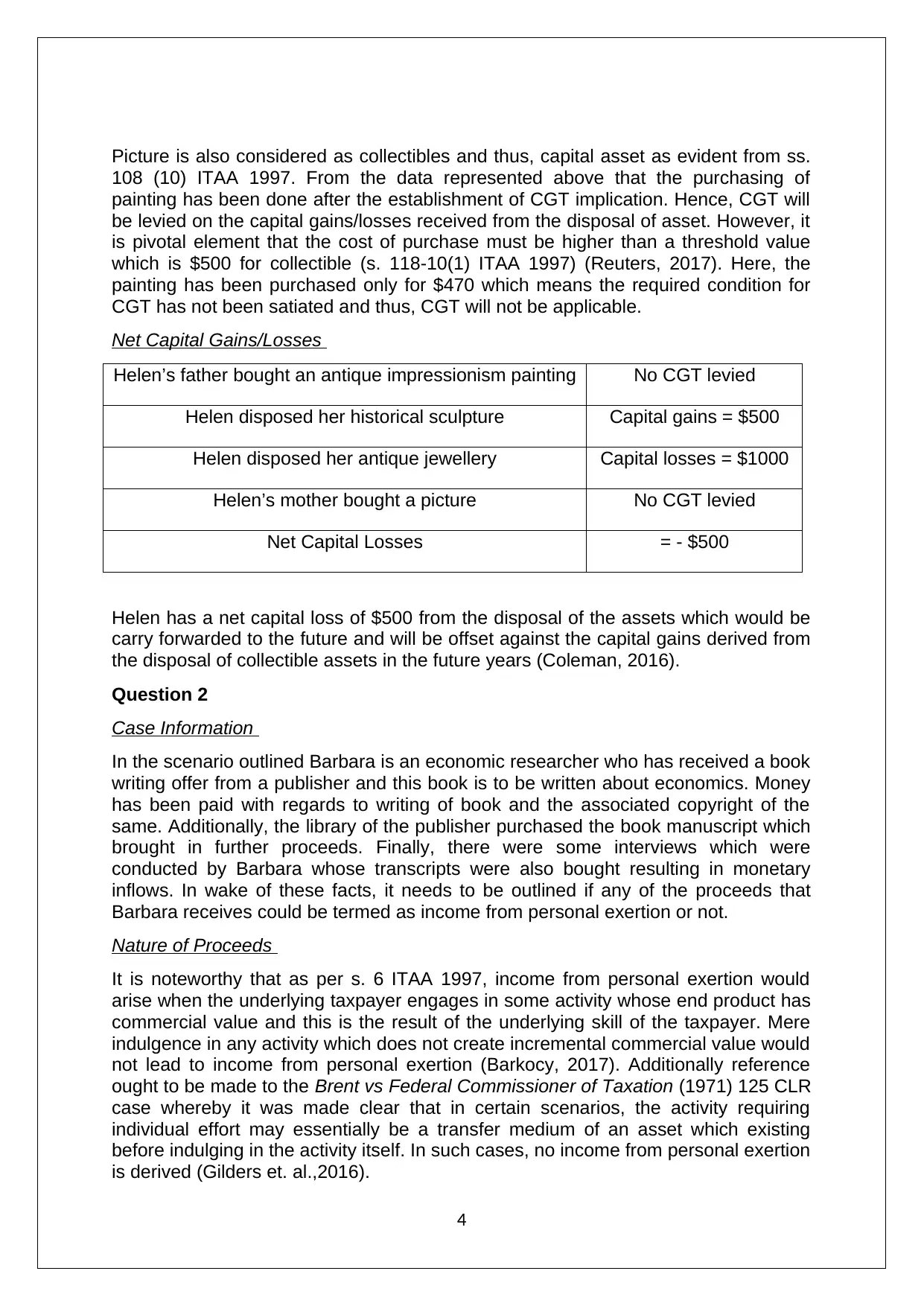
Picture is also considered as collectibles and thus, capital asset as evident from ss.
108 (10) ITAA 1997. From the data represented above that the purchasing of
painting has been done after the establishment of CGT implication. Hence, CGT will
be levied on the capital gains/losses received from the disposal of asset. However, it
is pivotal element that the cost of purchase must be higher than a threshold value
which is $500 for collectible (s. 118-10(1) ITAA 1997) (Reuters, 2017). Here, the
painting has been purchased only for $470 which means the required condition for
CGT has not been satiated and thus, CGT will not be applicable.
Net Capital Gains/Losses
Helen’s father bought an antique impressionism painting No CGT levied
Helen disposed her historical sculpture Capital gains = $500
Helen disposed her antique jewellery Capital losses = $1000
Helen’s mother bought a picture No CGT levied
Net Capital Losses = - $500
Helen has a net capital loss of $500 from the disposal of the assets which would be
carry forwarded to the future and will be offset against the capital gains derived from
the disposal of collectible assets in the future years (Coleman, 2016).
Question 2
Case Information
In the scenario outlined Barbara is an economic researcher who has received a book
writing offer from a publisher and this book is to be written about economics. Money
has been paid with regards to writing of book and the associated copyright of the
same. Additionally, the library of the publisher purchased the book manuscript which
brought in further proceeds. Finally, there were some interviews which were
conducted by Barbara whose transcripts were also bought resulting in monetary
inflows. In wake of these facts, it needs to be outlined if any of the proceeds that
Barbara receives could be termed as income from personal exertion or not.
Nature of Proceeds
It is noteworthy that as per s. 6 ITAA 1997, income from personal exertion would
arise when the underlying taxpayer engages in some activity whose end product has
commercial value and this is the result of the underlying skill of the taxpayer. Mere
indulgence in any activity which does not create incremental commercial value would
not lead to income from personal exertion (Barkocy, 2017). Additionally reference
ought to be made to the Brent vs Federal Commissioner of Taxation (1971) 125 CLR
case whereby it was made clear that in certain scenarios, the activity requiring
individual effort may essentially be a transfer medium of an asset which existing
before indulging in the activity itself. In such cases, no income from personal exertion
is derived (Gilders et. al.,2016).
4
108 (10) ITAA 1997. From the data represented above that the purchasing of
painting has been done after the establishment of CGT implication. Hence, CGT will
be levied on the capital gains/losses received from the disposal of asset. However, it
is pivotal element that the cost of purchase must be higher than a threshold value
which is $500 for collectible (s. 118-10(1) ITAA 1997) (Reuters, 2017). Here, the
painting has been purchased only for $470 which means the required condition for
CGT has not been satiated and thus, CGT will not be applicable.
Net Capital Gains/Losses
Helen’s father bought an antique impressionism painting No CGT levied
Helen disposed her historical sculpture Capital gains = $500
Helen disposed her antique jewellery Capital losses = $1000
Helen’s mother bought a picture No CGT levied
Net Capital Losses = - $500
Helen has a net capital loss of $500 from the disposal of the assets which would be
carry forwarded to the future and will be offset against the capital gains derived from
the disposal of collectible assets in the future years (Coleman, 2016).
Question 2
Case Information
In the scenario outlined Barbara is an economic researcher who has received a book
writing offer from a publisher and this book is to be written about economics. Money
has been paid with regards to writing of book and the associated copyright of the
same. Additionally, the library of the publisher purchased the book manuscript which
brought in further proceeds. Finally, there were some interviews which were
conducted by Barbara whose transcripts were also bought resulting in monetary
inflows. In wake of these facts, it needs to be outlined if any of the proceeds that
Barbara receives could be termed as income from personal exertion or not.
Nature of Proceeds
It is noteworthy that as per s. 6 ITAA 1997, income from personal exertion would
arise when the underlying taxpayer engages in some activity whose end product has
commercial value and this is the result of the underlying skill of the taxpayer. Mere
indulgence in any activity which does not create incremental commercial value would
not lead to income from personal exertion (Barkocy, 2017). Additionally reference
ought to be made to the Brent vs Federal Commissioner of Taxation (1971) 125 CLR
case whereby it was made clear that in certain scenarios, the activity requiring
individual effort may essentially be a transfer medium of an asset which existing
before indulging in the activity itself. In such cases, no income from personal exertion
is derived (Gilders et. al.,2016).
4
Paraphrase This Document
Need a fresh take? Get an instant paraphrase of this document with our AI Paraphraser
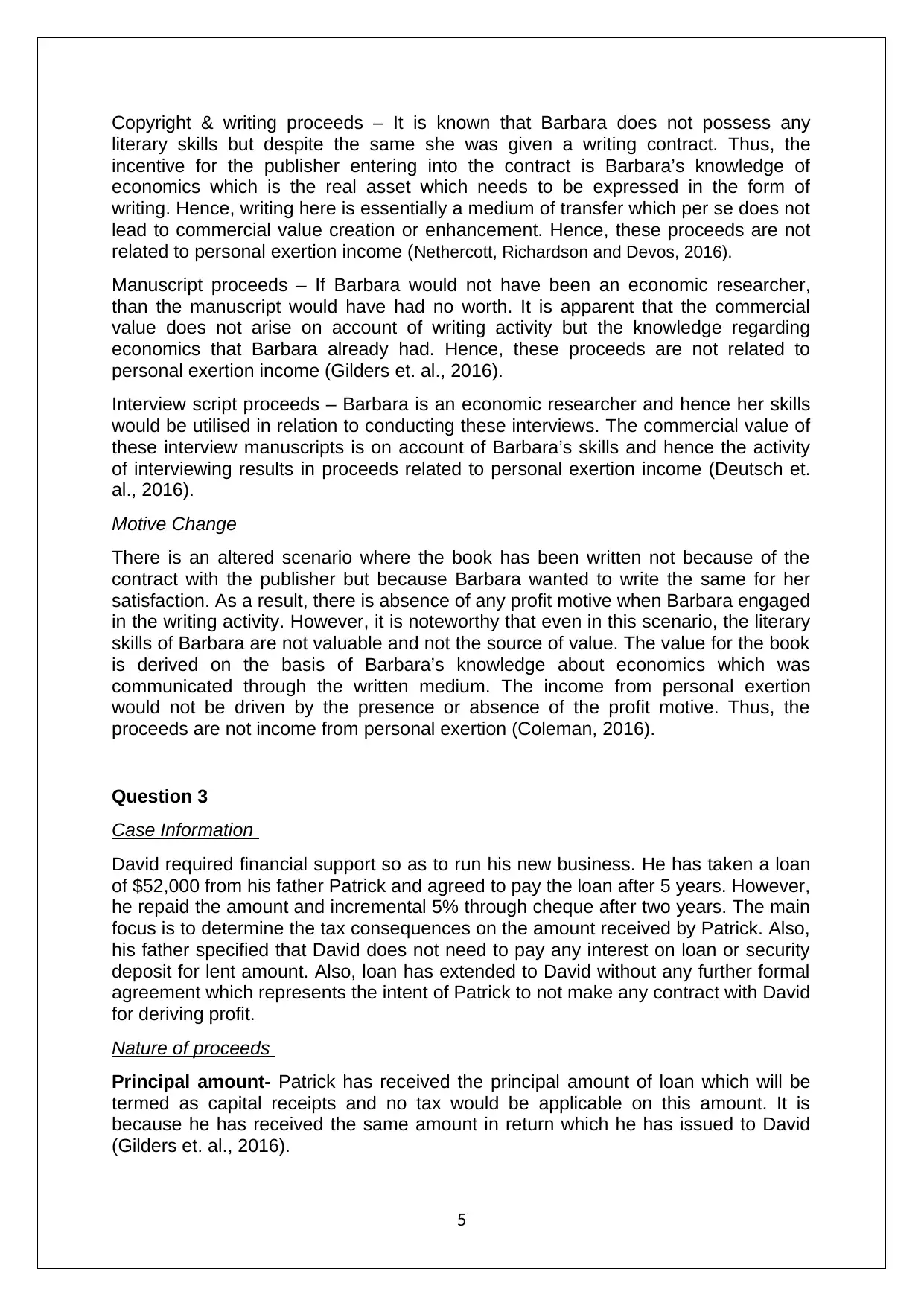
Copyright & writing proceeds – It is known that Barbara does not possess any
literary skills but despite the same she was given a writing contract. Thus, the
incentive for the publisher entering into the contract is Barbara’s knowledge of
economics which is the real asset which needs to be expressed in the form of
writing. Hence, writing here is essentially a medium of transfer which per se does not
lead to commercial value creation or enhancement. Hence, these proceeds are not
related to personal exertion income (Nethercott, Richardson and Devos, 2016).
Manuscript proceeds – If Barbara would not have been an economic researcher,
than the manuscript would have had no worth. It is apparent that the commercial
value does not arise on account of writing activity but the knowledge regarding
economics that Barbara already had. Hence, these proceeds are not related to
personal exertion income (Gilders et. al., 2016).
Interview script proceeds – Barbara is an economic researcher and hence her skills
would be utilised in relation to conducting these interviews. The commercial value of
these interview manuscripts is on account of Barbara’s skills and hence the activity
of interviewing results in proceeds related to personal exertion income (Deutsch et.
al., 2016).
Motive Change
There is an altered scenario where the book has been written not because of the
contract with the publisher but because Barbara wanted to write the same for her
satisfaction. As a result, there is absence of any profit motive when Barbara engaged
in the writing activity. However, it is noteworthy that even in this scenario, the literary
skills of Barbara are not valuable and not the source of value. The value for the book
is derived on the basis of Barbara’s knowledge about economics which was
communicated through the written medium. The income from personal exertion
would not be driven by the presence or absence of the profit motive. Thus, the
proceeds are not income from personal exertion (Coleman, 2016).
Question 3
Case Information
David required financial support so as to run his new business. He has taken a loan
of $52,000 from his father Patrick and agreed to pay the loan after 5 years. However,
he repaid the amount and incremental 5% through cheque after two years. The main
focus is to determine the tax consequences on the amount received by Patrick. Also,
his father specified that David does not need to pay any interest on loan or security
deposit for lent amount. Also, loan has extended to David without any further formal
agreement which represents the intent of Patrick to not make any contract with David
for deriving profit.
Nature of proceeds
Principal amount- Patrick has received the principal amount of loan which will be
termed as capital receipts and no tax would be applicable on this amount. It is
because he has received the same amount in return which he has issued to David
(Gilders et. al., 2016).
5
literary skills but despite the same she was given a writing contract. Thus, the
incentive for the publisher entering into the contract is Barbara’s knowledge of
economics which is the real asset which needs to be expressed in the form of
writing. Hence, writing here is essentially a medium of transfer which per se does not
lead to commercial value creation or enhancement. Hence, these proceeds are not
related to personal exertion income (Nethercott, Richardson and Devos, 2016).
Manuscript proceeds – If Barbara would not have been an economic researcher,
than the manuscript would have had no worth. It is apparent that the commercial
value does not arise on account of writing activity but the knowledge regarding
economics that Barbara already had. Hence, these proceeds are not related to
personal exertion income (Gilders et. al., 2016).
Interview script proceeds – Barbara is an economic researcher and hence her skills
would be utilised in relation to conducting these interviews. The commercial value of
these interview manuscripts is on account of Barbara’s skills and hence the activity
of interviewing results in proceeds related to personal exertion income (Deutsch et.
al., 2016).
Motive Change
There is an altered scenario where the book has been written not because of the
contract with the publisher but because Barbara wanted to write the same for her
satisfaction. As a result, there is absence of any profit motive when Barbara engaged
in the writing activity. However, it is noteworthy that even in this scenario, the literary
skills of Barbara are not valuable and not the source of value. The value for the book
is derived on the basis of Barbara’s knowledge about economics which was
communicated through the written medium. The income from personal exertion
would not be driven by the presence or absence of the profit motive. Thus, the
proceeds are not income from personal exertion (Coleman, 2016).
Question 3
Case Information
David required financial support so as to run his new business. He has taken a loan
of $52,000 from his father Patrick and agreed to pay the loan after 5 years. However,
he repaid the amount and incremental 5% through cheque after two years. The main
focus is to determine the tax consequences on the amount received by Patrick. Also,
his father specified that David does not need to pay any interest on loan or security
deposit for lent amount. Also, loan has extended to David without any further formal
agreement which represents the intent of Patrick to not make any contract with David
for deriving profit.
Nature of proceeds
Principal amount- Patrick has received the principal amount of loan which will be
termed as capital receipts and no tax would be applicable on this amount. It is
because he has received the same amount in return which he has issued to David
(Gilders et. al., 2016).
5
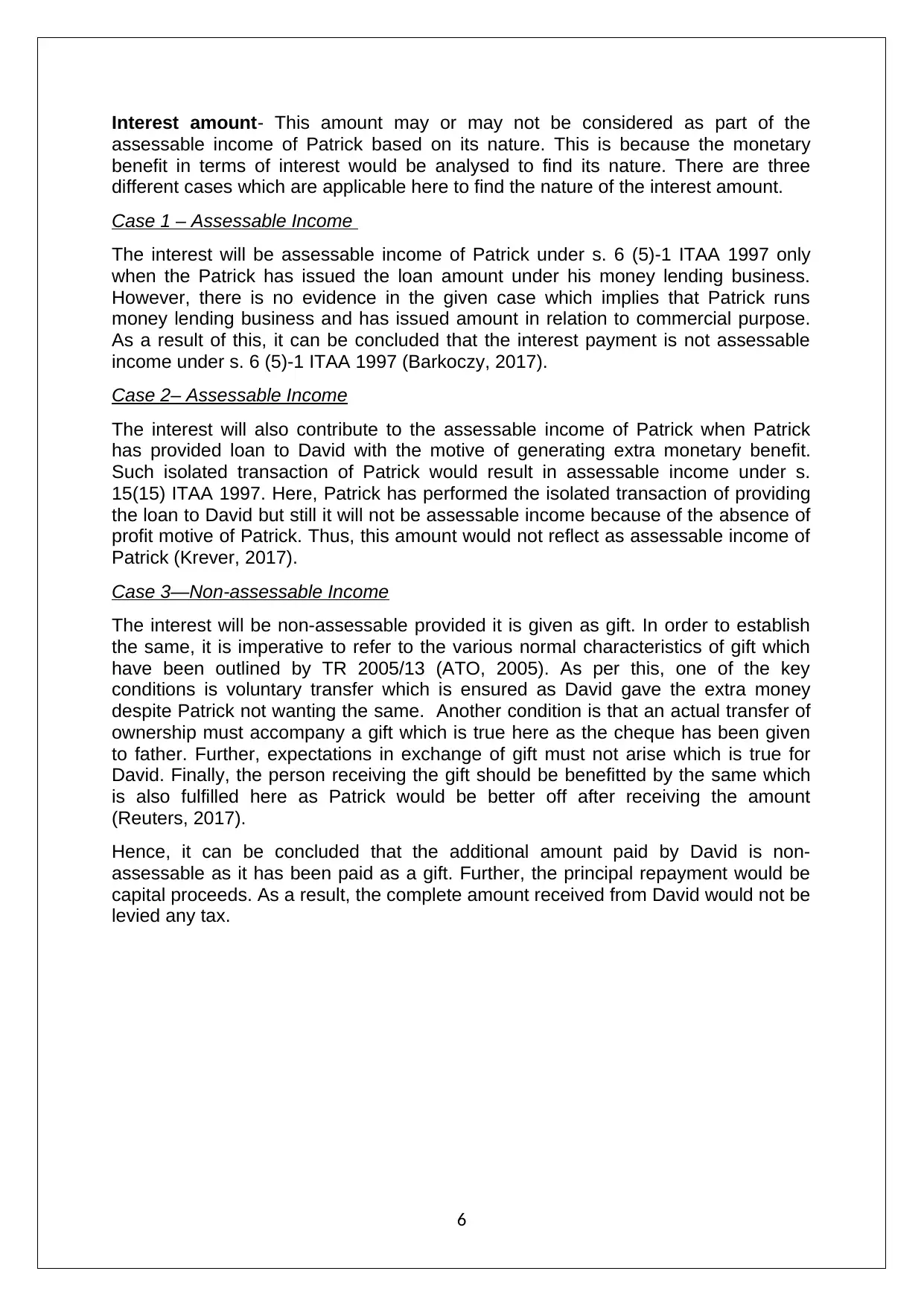
Interest amount- This amount may or may not be considered as part of the
assessable income of Patrick based on its nature. This is because the monetary
benefit in terms of interest would be analysed to find its nature. There are three
different cases which are applicable here to find the nature of the interest amount.
Case 1 – Assessable Income
The interest will be assessable income of Patrick under s. 6 (5)-1 ITAA 1997 only
when the Patrick has issued the loan amount under his money lending business.
However, there is no evidence in the given case which implies that Patrick runs
money lending business and has issued amount in relation to commercial purpose.
As a result of this, it can be concluded that the interest payment is not assessable
income under s. 6 (5)-1 ITAA 1997 (Barkoczy, 2017).
Case 2– Assessable Income
The interest will also contribute to the assessable income of Patrick when Patrick
has provided loan to David with the motive of generating extra monetary benefit.
Such isolated transaction of Patrick would result in assessable income under s.
15(15) ITAA 1997. Here, Patrick has performed the isolated transaction of providing
the loan to David but still it will not be assessable income because of the absence of
profit motive of Patrick. Thus, this amount would not reflect as assessable income of
Patrick (Krever, 2017).
Case 3—Non-assessable Income
The interest will be non-assessable provided it is given as gift. In order to establish
the same, it is imperative to refer to the various normal characteristics of gift which
have been outlined by TR 2005/13 (ATO, 2005). As per this, one of the key
conditions is voluntary transfer which is ensured as David gave the extra money
despite Patrick not wanting the same. Another condition is that an actual transfer of
ownership must accompany a gift which is true here as the cheque has been given
to father. Further, expectations in exchange of gift must not arise which is true for
David. Finally, the person receiving the gift should be benefitted by the same which
is also fulfilled here as Patrick would be better off after receiving the amount
(Reuters, 2017).
Hence, it can be concluded that the additional amount paid by David is non-
assessable as it has been paid as a gift. Further, the principal repayment would be
capital proceeds. As a result, the complete amount received from David would not be
levied any tax.
6
assessable income of Patrick based on its nature. This is because the monetary
benefit in terms of interest would be analysed to find its nature. There are three
different cases which are applicable here to find the nature of the interest amount.
Case 1 – Assessable Income
The interest will be assessable income of Patrick under s. 6 (5)-1 ITAA 1997 only
when the Patrick has issued the loan amount under his money lending business.
However, there is no evidence in the given case which implies that Patrick runs
money lending business and has issued amount in relation to commercial purpose.
As a result of this, it can be concluded that the interest payment is not assessable
income under s. 6 (5)-1 ITAA 1997 (Barkoczy, 2017).
Case 2– Assessable Income
The interest will also contribute to the assessable income of Patrick when Patrick
has provided loan to David with the motive of generating extra monetary benefit.
Such isolated transaction of Patrick would result in assessable income under s.
15(15) ITAA 1997. Here, Patrick has performed the isolated transaction of providing
the loan to David but still it will not be assessable income because of the absence of
profit motive of Patrick. Thus, this amount would not reflect as assessable income of
Patrick (Krever, 2017).
Case 3—Non-assessable Income
The interest will be non-assessable provided it is given as gift. In order to establish
the same, it is imperative to refer to the various normal characteristics of gift which
have been outlined by TR 2005/13 (ATO, 2005). As per this, one of the key
conditions is voluntary transfer which is ensured as David gave the extra money
despite Patrick not wanting the same. Another condition is that an actual transfer of
ownership must accompany a gift which is true here as the cheque has been given
to father. Further, expectations in exchange of gift must not arise which is true for
David. Finally, the person receiving the gift should be benefitted by the same which
is also fulfilled here as Patrick would be better off after receiving the amount
(Reuters, 2017).
Hence, it can be concluded that the additional amount paid by David is non-
assessable as it has been paid as a gift. Further, the principal repayment would be
capital proceeds. As a result, the complete amount received from David would not be
levied any tax.
6
⊘ This is a preview!⊘
Do you want full access?
Subscribe today to unlock all pages.

Trusted by 1+ million students worldwide
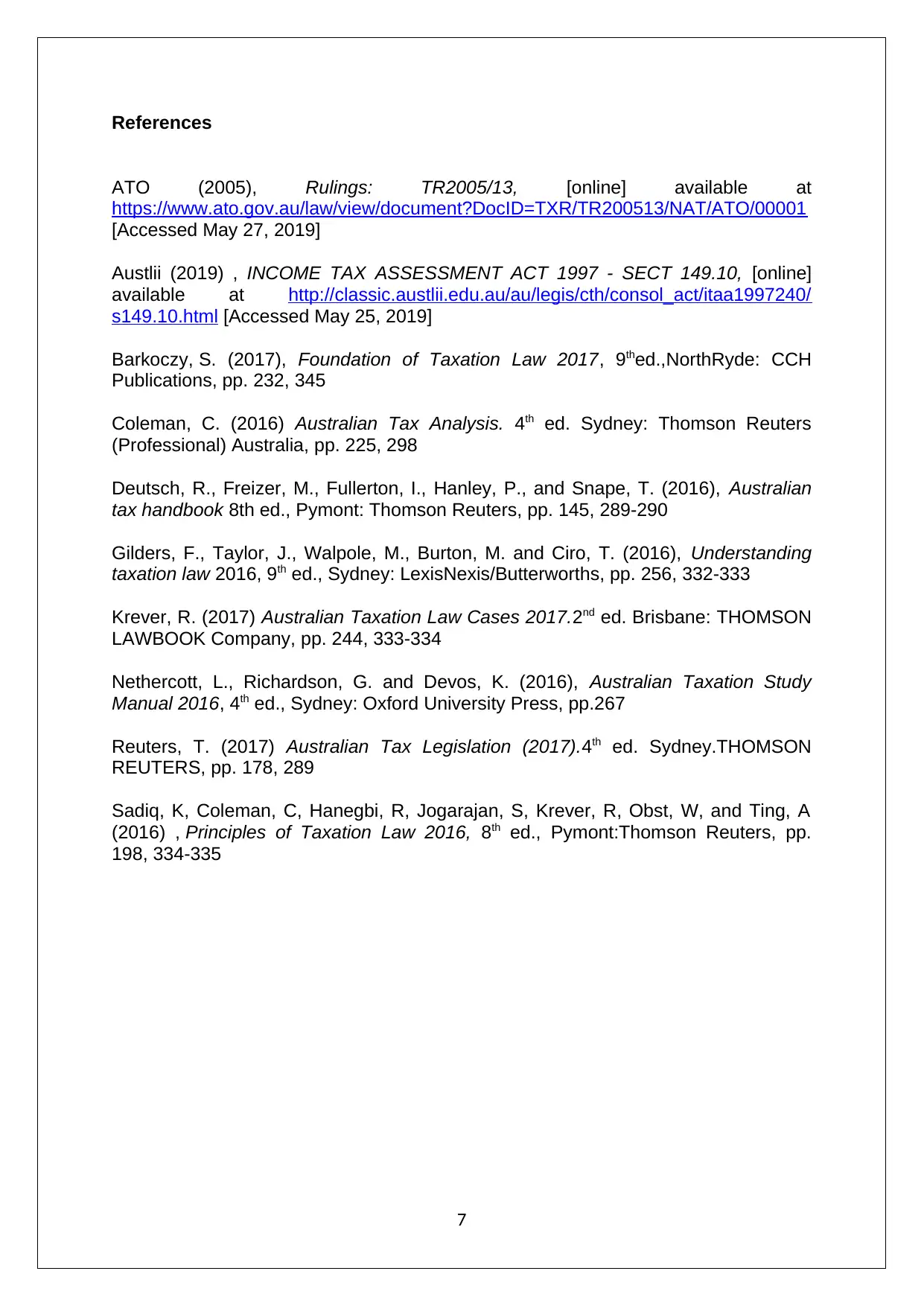
References
ATO (2005), Rulings: TR2005/13, [online] available at
https://www.ato.gov.au/law/view/document?DocID=TXR/TR200513/NAT/ATO/00001
[Accessed May 27, 2019]
Austlii (2019) , INCOME TAX ASSESSMENT ACT 1997 - SECT 149.10, [online]
available at http://classic.austlii.edu.au/au/legis/cth/consol_act/itaa1997240/
s149.10.html [Accessed May 25, 2019]
Barkoczy, S. (2017), Foundation of Taxation Law 2017, 9thed.,NorthRyde: CCH
Publications, pp. 232, 345
Coleman, C. (2016) Australian Tax Analysis. 4th ed. Sydney: Thomson Reuters
(Professional) Australia, pp. 225, 298
Deutsch, R., Freizer, M., Fullerton, I., Hanley, P., and Snape, T. (2016), Australian
tax handbook 8th ed., Pymont: Thomson Reuters, pp. 145, 289-290
Gilders, F., Taylor, J., Walpole, M., Burton, M. and Ciro, T. (2016), Understanding
taxation law 2016, 9th ed., Sydney: LexisNexis/Butterworths, pp. 256, 332-333
Krever, R. (2017) Australian Taxation Law Cases 2017.2nd ed. Brisbane: THOMSON
LAWBOOK Company, pp. 244, 333-334
Nethercott, L., Richardson, G. and Devos, K. (2016), Australian Taxation Study
Manual 2016, 4th ed., Sydney: Oxford University Press, pp.267
Reuters, T. (2017) Australian Tax Legislation (2017).4th ed. Sydney.THOMSON
REUTERS, pp. 178, 289
Sadiq, K, Coleman, C, Hanegbi, R, Jogarajan, S, Krever, R, Obst, W, and Ting, A
(2016) , Principles of Taxation Law 2016, 8th ed., Pymont:Thomson Reuters, pp.
198, 334-335
7
ATO (2005), Rulings: TR2005/13, [online] available at
https://www.ato.gov.au/law/view/document?DocID=TXR/TR200513/NAT/ATO/00001
[Accessed May 27, 2019]
Austlii (2019) , INCOME TAX ASSESSMENT ACT 1997 - SECT 149.10, [online]
available at http://classic.austlii.edu.au/au/legis/cth/consol_act/itaa1997240/
s149.10.html [Accessed May 25, 2019]
Barkoczy, S. (2017), Foundation of Taxation Law 2017, 9thed.,NorthRyde: CCH
Publications, pp. 232, 345
Coleman, C. (2016) Australian Tax Analysis. 4th ed. Sydney: Thomson Reuters
(Professional) Australia, pp. 225, 298
Deutsch, R., Freizer, M., Fullerton, I., Hanley, P., and Snape, T. (2016), Australian
tax handbook 8th ed., Pymont: Thomson Reuters, pp. 145, 289-290
Gilders, F., Taylor, J., Walpole, M., Burton, M. and Ciro, T. (2016), Understanding
taxation law 2016, 9th ed., Sydney: LexisNexis/Butterworths, pp. 256, 332-333
Krever, R. (2017) Australian Taxation Law Cases 2017.2nd ed. Brisbane: THOMSON
LAWBOOK Company, pp. 244, 333-334
Nethercott, L., Richardson, G. and Devos, K. (2016), Australian Taxation Study
Manual 2016, 4th ed., Sydney: Oxford University Press, pp.267
Reuters, T. (2017) Australian Tax Legislation (2017).4th ed. Sydney.THOMSON
REUTERS, pp. 178, 289
Sadiq, K, Coleman, C, Hanegbi, R, Jogarajan, S, Krever, R, Obst, W, and Ting, A
(2016) , Principles of Taxation Law 2016, 8th ed., Pymont:Thomson Reuters, pp.
198, 334-335
7
1 out of 7
Related Documents
Your All-in-One AI-Powered Toolkit for Academic Success.
+13062052269
info@desklib.com
Available 24*7 on WhatsApp / Email
![[object Object]](/_next/static/media/star-bottom.7253800d.svg)
Unlock your academic potential
Copyright © 2020–2026 A2Z Services. All Rights Reserved. Developed and managed by ZUCOL.





